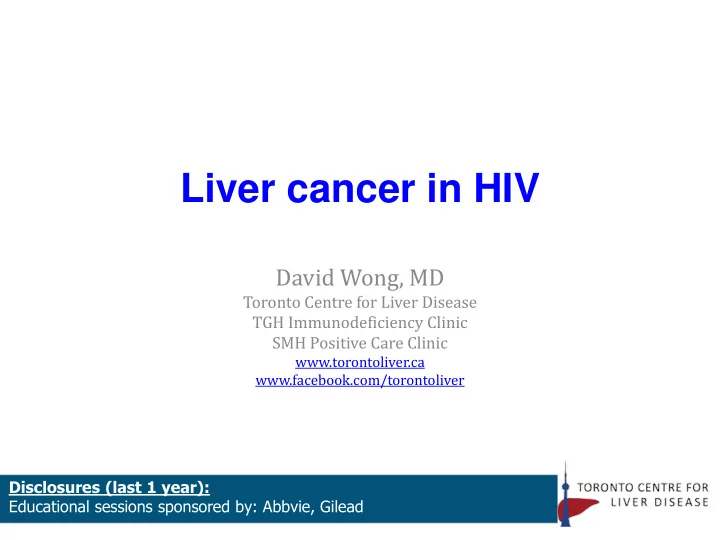

Liver cancer in HIV David Wong, MD Toronto Centre for Liver Disease TGH Immunodeficiency Clinic SMH Positive Care Clinic www.torontoliver.ca www.facebook.com/torontoliver Disclosures (last 1 year): Educational sessions sponsored by: Abbvie, Gilead
Speaker disclosure Potential conflict Disclosure - if potential conflict of interest exists Direct financial interest in a company None Investments in a company None Membership on a company’s Advisory None Board Principal Investigator in a clinical trial Gilead: Harvoni for HCV-HIV, Tenofovir for HBV sponsored by a company Abbvie: Holkira for HCV (long term follow-up) Research sponsored by a company None ADDITIONAL TEXT EXAMPLE Consultant fees paid by a company None
Outline • Identifying those at risk for liver cancer – Cirrhosis (thrombocytopenia) – Chronic hepatitis B (HBsAg positive) • Screening for liver cancer – Who and how to screen • Diagnosis and management
Background • “Hepatoma” is hepatocellular carcinoma • Main risks – Cirrhosis (must survive long enough) • Fatty liver: alcohol, diabetes (metabolic syndrome) • Viral: HBV, HCV – Chronic HBV infection
Cancer in Ontario
Natural history of chronic liver disease
Liver disease trends in Ontario • Alcohol still common? • Fatty liver increasing – Cardiovascular mortality still higher • Hepatitis B treatable since 2002-2006 – Liver failure uncommon – Treatment decreases (delays) risk • Hepatitis C treatable since 2014 – Cure of infection decreases risk in cirrhotics
Who is at risk? • Chronic hepatitis – Abnormal liver enzymes > 6 months – Hepatitis: usually ALT > AST • Ratio reverses in advanced cirrhosis • Enzymes can be normal • Chronic HBV infection – HBsAg positive > 6 months • NB NOT HBsAg negative, anti-HBc positive • Cirrhosis Liver failure INR Bilirubin – Thrombocytopenia (Plts < 150) Platelets Albumin
Earlier stage cirrhosis • Non-invasive markers of liver fibrosis – APRI (Platelets fall, AST rise) – FIB-4 (as above, add age and ALT) – Fibrotest (GGT rises, haptoglobin falls, bilirubin rises, a 2-macroglobulin rises) – Fibroscan (liver stiffness increases) • Liver biopsy
Screening • Cost effective if risk is great enough – >1.5% per year – True for untreated cirrhosis – Chronic HBV in Asians • Male > 40 years old • Female > 50 years old • Risk significantly reduced for – HBV cirrhosis where HBV suppressed – HCV cirrhosis where HCV eradicated
How to screen • Worthwhile if you would treat cancer if found – Good performance status/survival otherwise – Willing to have cancer treatment • Ultrasound q6-12 monthly – Looking for a new or growing nodule • Serum AFP – Better confirmation test like CEA • Goes up with hepatitis flare (non-specific) • Only elevated with large cancers (non-sensitive)
Confirmation of cancer > 1 cm • Biopsy usually NOT needed • Contrast enhanced imaging (US, CT, MRI) – Arterial enhancement “Hypervascular” – Delayed washout • Biopsy only if concerning but not diagnostic by imaging
What to do with hepatoma • Child Pugh – A: 0 – B: 1 – C: 2 • Tumor morphology – Uninodular <50%: 0 – Multinodular <50%: 1 – Masive > 50%: 2 • AFP – <400: 0 – >400: 1 • Vascular invasion – No: 0 – Yes: 1
Management • If decompensated cirrhosis – Transplant is only treatment for hepatoma – No role for cancer screening if not a transplant candidate • Age > 70 • Recent other cancer (<5 years) • Unable to stop drinking alcohol
Hepatoma treatment • Curative – Ablation if up to 3 lesions <2.5 cm – Resection • Relatively safe if platelets > 100, liver function normal – Transplant • Organ availability is limiting • Palliative – TACE chemotherapy – Sorafenib – Radiation – Experimental protocols (immune break inhibitors)
Summary • Liver cancer is increasing because patients are surviving long enough to have cirrhosis for a long time • Liver cancer risk is decreased if the primary liver disease is treated – Investigate all with chronic hepatitis (ALT/AST) – Screen for HBV (HBsAg) and HCV (anti-HCV) – Tests for cirrhosis • Screening ultrasound is cost effective if risk is >1.5% per year – Untreated cirrhosis – Untreated HBV infection older individuals
Recommend
More recommend